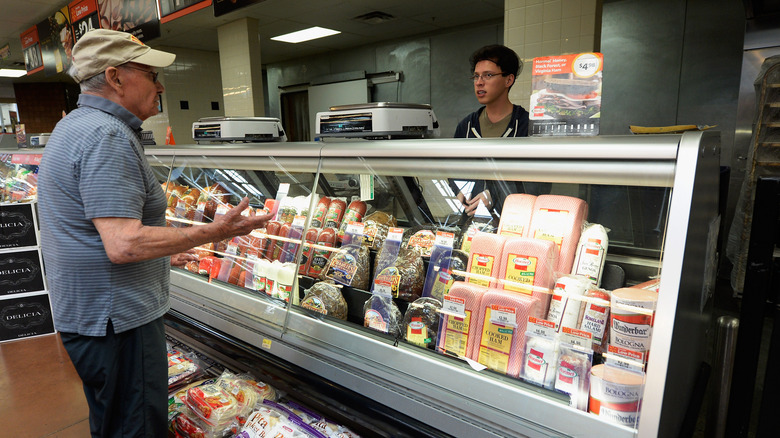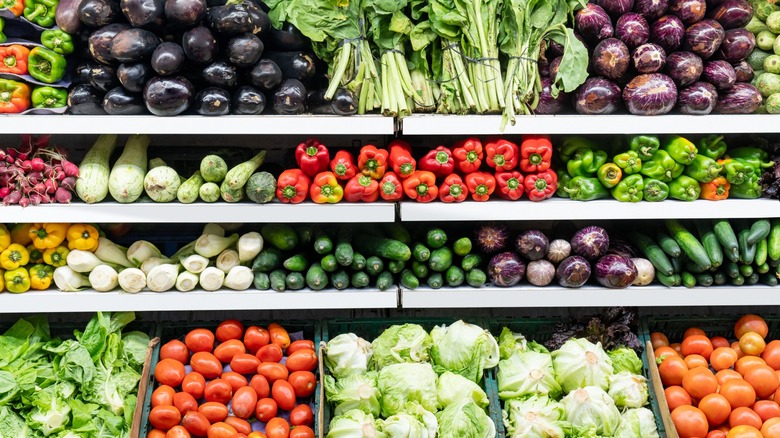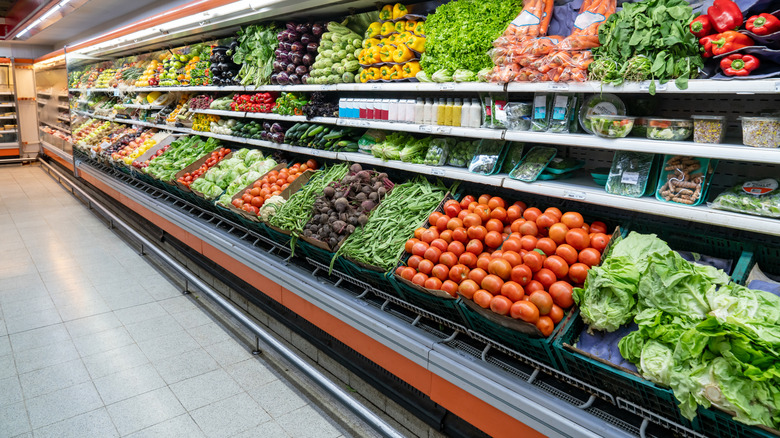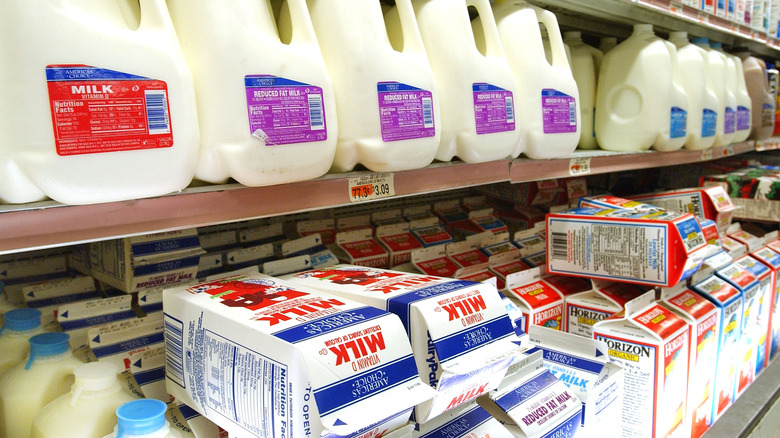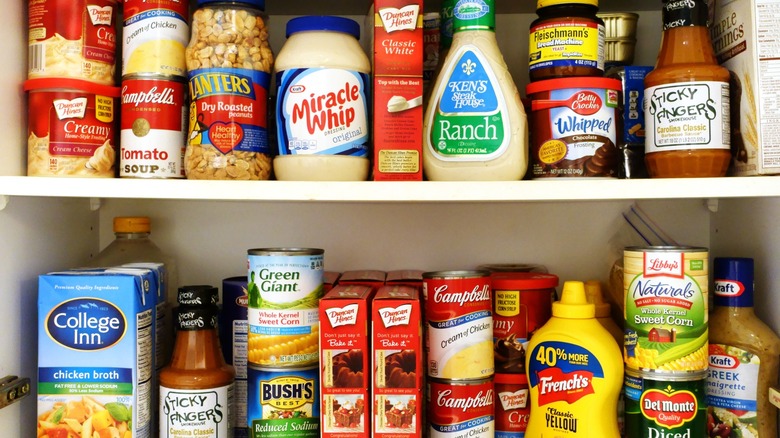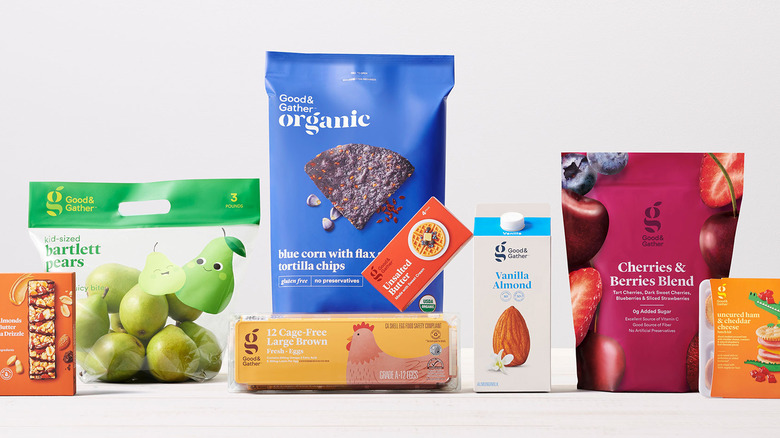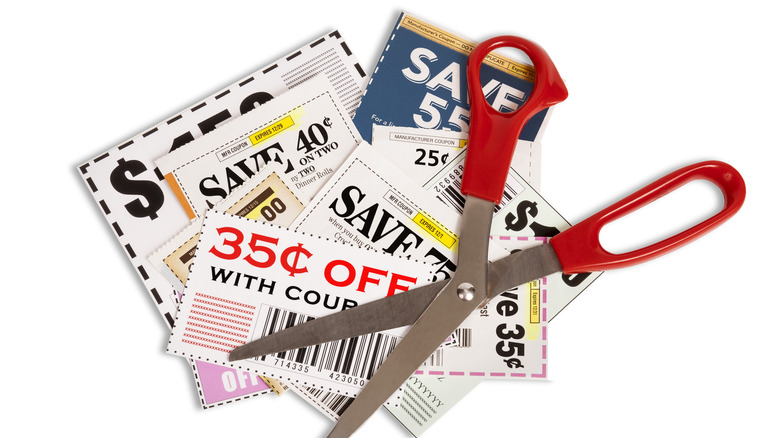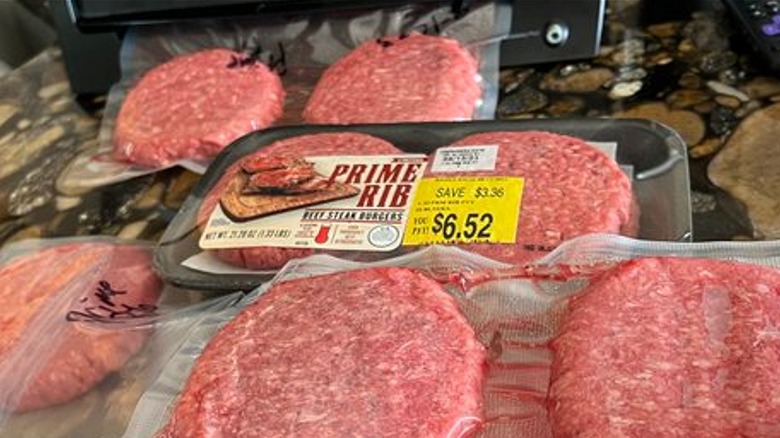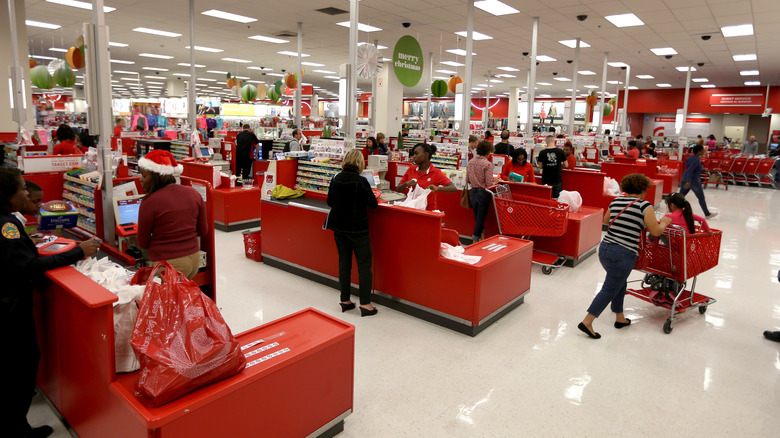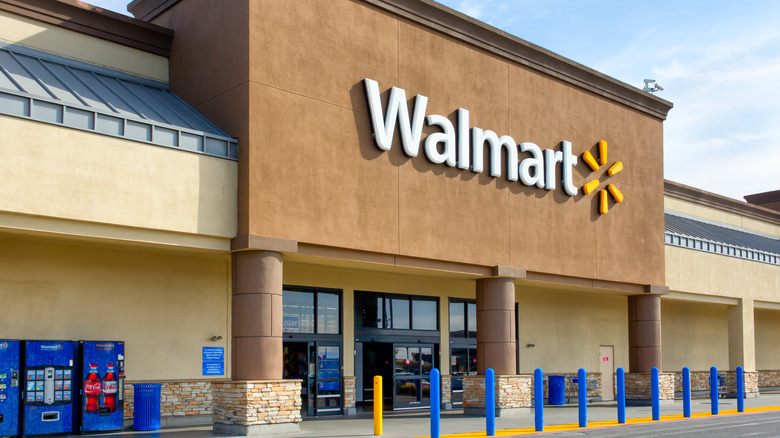Walmart Vs Target: What To Know Before Grocery Shopping At Each
It may have sent shockwaves through the grocery world when Walmart started carrying groceries in 1988, with Target following suit in 1995. The move certainly had grocery chains quaking in their produce sections as they scrambled to keep their customer base coming through the doors. Three decades and change later, grabbing groceries at these two leading companies is a no-brainer, especially when time is tight and funds are trim. With the ever-evolving grocery store landscape shifting at will, Walmart and Target have become formidable alternatives for shoppers. But are Target grocery prices really higher than the average retailer? And is buying groceries at Walmart ever a good idea?
With both retailers slinging eats and treats to an always-hungry audience, there's bound to be a preference among shoppers — a distinction made not just by the store itself but also by the quality, availability, and price of the groceries found in each. It's important to shop comparatively to make sure you're getting the best deal and making the most of your time. We wondered how Walmart and Target match up when it comes to getting grub where you also get your guitars and garden gear. So we did a little comparison to quell the curiosity and help you make more informed shopping decisions. To keep things balanced, we focused on Walmart and Target Superstores and left out the stand-alone Walmart Neighborhood Market. Having shopped at both extensively, we have an insider's view of what sells and what doesn't at each.
Target stocks less meat than Walmart and doesn't have a deli
You're out of luck if you're heading to Target to pick up a half pound of turkey or sliced Gouda for Sunday brunch. A fresh deli counter is a deletion from the grocery section that the big-box retailer makes in favor of packaged items in the refrigerator section instead. You'll still find tubs of hummus and packets of salami, but the pickings are restricted to the brands Target prefers. While this cuts down on Target's need for floor space, added refrigeration, and all the licensing and regulation that goes with fresh food maintenance, it also means you'll need to make a second stop to pick up your deli goods elsewhere — not the most convenient deal.
Meanwhile at Walmart, there's a full-function deli complete with meat slicers and cases displaying cheese, meat, and salads, just like a dedicated grocery store offers. You can even order 6-foot subs for your tailgating hullabaloo. There's a full staff working behind the counter to accommodate your needs for thinner slices, a mix of meats, or advice on what flavors work best together for your colossal cookout or intimate dinner party. Aside from having fresher options than Target, Walmart also offers a wider variety of cold cuts available in customizable sizes to suit your every whim. And as for butchered meat, poultry, and fresh seafood, you'll find an incredible array of options in Walmart's expansive refrigerator cases, while Target keeps its selections much trimmer.
Target's produce section is limited
Anyone who's walked through Target on a search for strawberries already knows how trim the produce section is. It's contained to a small-ish section and features only a handful of selections, which is never helpful when trying to conquer your weekly grocery gathering. There's also no produce manager available to answer questions about the freshness of the fruits on hand or to field special orders for unusual items, a feature that comes standard with full-service grocery stores. So while you might be able to grab bananas and bagged salad on your Target produce shopping excursion, those dragon fruit smoothies you're itching to make will require a visit to a more all-encompassing grocer.
On the other hand, Walmart devotes an entire wing of its grocery section to produce of all sorts and sizes, everything from mushrooms to watermelon, and even some organic items. You can harvest a whole bushel of salad fixings, stock your fruit basket, and pick up a vast and varied array of fresh vegetables to snack on throughout the week. You'll also find helpful staff busily stocking the stands, available to field your concerns about how recently the cantaloupes arrived and how long your spinach will last in the crisper drawer. It's a much fuller experience than Target offers, making one-stop shopping an easier task.
Walmart's produce isn't always priced better than larger grocery chains
Though you'll find pretty much everything you need in Walmart's produce section, you won't necessarily find it at those famous low, low Walmart prices. Depending on your location, you'll see seasonal selections come and go at a customer cost in line with competing Kroger or Albertsons locations. And because Walmart doesn't go overboard with tagged shelf sales like those retailers do, you aren't likely to see major discounts called out like you're used to seeing. This sort of uncertainty can put comparative shopping back on your white board if you're looking to save cash.
There are many reasons to be wary of Walmart produce, despite the plentiful possibilities. But even with non-competitive pricing, Walmart's produce is still generally affordable. If taking the time to sort through sales and websites to lock in a 10-cent savings on tomatoes isn't the best use of your day, you can always toss the Walmart goods into your cart and head for the checkout knowing you're getting a fair-ish deal, at the very least.
Target has better dairy prices
Surprise to the milk-lovers in the house! Target currently charges less for a gallon of moo juice than Walmart, something of a stunner considering the volume Walmart stocks around the U.S. Recent prices put a gallon of Good & Gather whole milk at Target at $1.99, while Walmart prices its Great Value gallon jug at $2.12. But egg fans find themselves in the opposite basket; a dozen eggs currently costs $2.59 at Target and $2.53 at Walmart, turning the price tables ever so slightly. The savings may not be substantial, but the psychological joy of paying even a penny less than $2 for a gallon of milk can drive shoppers to the dairy case of the store with the best sticker price. Of course, dairy prices fluctuate as frequently as the stock market, so you may find a switch between Target and Walmart any minute now.
While both Target and Walmart stock a full supply of milk, eggs, and other dairy items, the prices can fluctuate wildly due to a long list of influences. But shifting prices everywhere are inherent in the grocery shopping world, and shoppers with a keen sense for how much their favorites and must-haves should cost will always know if they see a decent deal or if they can find better elsewhere. For the moment, it appears that the difference is nominal, but keeping your eyes open will help you make more informed choices between the two outlets.
Both stores have massive refrigerated and frozen foods sections
Where you'll find the most impressive version of big-box grocery shopping by far is in the refrigerated and frozen food sections of both Walmart and Target. These areas consume a great deal of real estate in the grocery wings of the locations they occupy and offer a refreshingly robust range of pre-made heat-and-eat food. Whether you're stocking up on frozen pizzas or shopping for burgers for the big weekend barbecue, you'll find your favorite brands at Walmart as well as Great Value analogs that let you choose the price and quality that work best for your needs.
Likewise, Target is the perfect spot to load up on ice cream, premade meals, and frozen sides to fill out your weekly home dining menus. The company carries the biggies in the food world while keeping a pleasing number of Good & Gather and Market Pantry options to woo you away from your favorites. If you're shopping for clothes or household décor and happen to see those popsicles you've been itching to try, remember to grab them on your way out. You don't want your Target frozen food finds melting all over your Magnolia throw pillows.
Target has pre-made specialty bakery items, while Walmart has a full bakery
Anyone who's dashed into Target to pick up a birthday gift and greeting card then swept past the bakery section for a celebratory cake has likely been stopped short by the limited selection they've found. We've been in the same boat — or shopping cart, as the case may be. Target's quaint stand of high-priced specialty items usually includes boxed cupcakes, cookies, donuts, and even a few deluxe options like tuxedo cakes and tiramisu. But it can be a wild goose chase pinning down something you already have in mind, especially when feeding a larger group without running up a huge bill. Bread may abound here, but dropping into a nearby store with a full-service bakery for a more customized shopping experience is almost always preferable to settling for what Target has on hand.
One of those nearby stores might include Walmart, which has one of the most impressive bakery sections we've seen. From affordable packaged items and grab-and-go donuts by the dozen baked fresh daily to single slices of fresh sweets and customizable cakes, the Walmart bakery has everything you need at prices you want. The options can be tempting enough to slow down your shopping pace for a much-needed respite from your usual rush, much different from Target's take-it-or-leave-it approach.
Target's canned and dry goods aisles can be somewhat lacking
A stroll through the dry goods and canned food sections at Target reveals a deceptively decent array of familiar pantry-fillers. You may see plenty of items you want and need, but look closer when you need something in particular, and you'll notice gaps in the brand selection, sometimes filled in by Target's home labels and sometimes not. It may come down to restricted shelf space, but we've encountered several instances over the years where a trip to a competing store was necessary to find what we were looking for. It isn't the worst situation in the world, but it is a drawback for a retailer you'd assume was providing a 360-degree grocery experience, only to find several degrees have gone missing.
Walmart is unafraid to pile on the dry goods options, providing the best-known brands next to its own store-based copycats. Sometimes, the choices can become almost overwhelming; in recent years, the company has taken to offering slim spacing for specialty brands and items that would make Trader Joe's curse its tropical print shirt. We've seen designer baking goods, health food finds, and international eats that threw us for a highly pleasant loop. It takes a discerning eye to find these choice extras, but knowing they're available at Walmart keeps us from having to scour the streets and the Internet for special things when we need them most.
Target has a broader selection of private labels
Walmart puts full focus on its Great Value label, which is an instant identifier of a less expensive way to shop in almost every section in the store. Though it does a phenomenal job of replicating brand-name products at reduced prices, it also reduces the quality in some instances. We've nearly choked on Great Value wheat crackers, the equivalent of Triscuits that are somehow dryer than the already welcome-mat texture of the original, and the Great Value dry cereals are usual lacking the luster of the better-known formulations they're based on.
Target takes a more measured approach to its signature labels, providing different levels of quality at prices that match. Starting in 1995 with the recently retired Archer Farms, Target aimed at the cost-conscious consumer with grocery items that competed with better-known items while offering similar quality goods. With Good & Gather, Target showcases a more upscale line of products like premium cheeses and thoughtfully packaged snacks mingling among familiar bags and boxes. And the Market Pantry banner presents a straightforward collection of lower-priced pantry staple copycats and must-haves like mustard, flour, and white bread.
Both stores take manufacturer coupons
Walmart keeps pace with other grocery retailers by accepting manufacturer coupons, that ongoing phenomenon that gets shoppers to home in on particular products by slashing prices via paper or digital codes. Knowing that cautious shoppers maximize coupon use to minimize the total on their receipts, Walmart can draw big business away from stand-alone grocers this way. With Walmart's Low Price Guarantee in place, eagle-eyed consumers can capitalize on the savings offered at other grocery stores to get an even better deal on the goods in their cart.
Target is also a player in the manufacturer coupon game, roping in savvy shoppers who don't mind clipping and snipping before they shop and save. Those in the know will also understand what we mean when we say Tuesday is the best day to grocery shop at Target. This is when the coupon shopper's equivalent of a total eclipse occurs, letting you compound your savings by using both Target store coupons and manufacturer coupons for the same purchase. And since Target also price-matches competitor ads and even its own online listings, slick shoppers can pile on the savings if they know how to play their cards (read: coupons) right.
Walmart has better grocery clearance sections
In our favorite Walmart locations, we find the boldly designated yellow-tag clearance section containing close-outs, markdowns, and overstocked items at substantial reductions in price in several departments. It's something of a treasure hunt, considering the capricious nature of what will be marked down at any given moment, but it's a must-stop spot for exploring the possibility of paying less than you would for similar items shelved at full prices, especially when the discounts take prices below the 50% mark. That can mean substantial savings. We've found liquor for upwards of 90% off, especially during the post-Christmas clean-out when stocking up for later can be a blessing into the new year.
In contrast, you'll find red-tagged clearance grocery items scattered about in Target's grocery section, and sometimes you'll find an endcap where the markdowns have accumulated for easier shopping. But we've never seen a thoroughly dedicated area where clearance goods are dependably located. The store does such a fantastic job with its general merchandise clearance sections that a second cart is sometimes required to catch the bounty. We keep hoping for a flagged area in the grocery aisles that treats marked down finds with the same respect. So far, the search has yielded hit-or-miss results.
Wherever you find clearance groceries, remember to always check sell-by dates and verify freshness before buying.
Target offers a discount program
If you're part of the Circle, you're already signed up for Target grocery discounts without even knowing it (or maybe you do know it, in which case, consider this an affirming reminder). Similar to the card- and app-based loyalty programs found at grocery retailers, this free membership service allows shoppers to apply added discounts to their food purchases. Think of it as sort of a Target food shopping hack, one that gives you access to considerable percentages off entire stock categories as well as specialized coupons you won't find anywhere else. It's your best bet for hitting the Target grocery shopping bullseye.
Ever the egalitarian retailer, Walmart eschews special sign-ups for discount programs, which leaves it out in the cold when it comes to coded membership specials for its most dedicated customers. The idea with the company is that all of its prices are as low as possible, and if they aren't, your coupons and price matching process should help. The distinction of Target shoppers receiving something exclusive that Walmart doesn't provide is a definite esteem driver that can make customers feel like there's something special happening at the big red bullseye that won't be coming to the big yellow spark anytime soon.
Verdict: Walmart has a larger selection that's more accessible and price-friendly than Target
There may be great overlap in the concept and convenience of buying groceries at Walmart and Target, but Walmart has the clear advantage in so many aspects of what grocery shoppers expect and need. Having deeper shelves with greater selection and a more obvious discount pricing structure lets Walmart provide more of what its shoppers need when groceries are at the top of the list, largely at prices that are fairly fair and square. Custom bakery orders, fresh deli and meat counter items, and a considerable collection of dry and canned foods allow customers to take care of their whole order in a single trip while showing off brands and house label items that provide a diversity of choice.
Target does a fine job of presenting its grocery stock, but the missing fresh sections are a notable omission that is likely to drive customers out of the store for add-ons they just won't find under the big red circle. And speaking of the Circle, the club-style discounts are certainly a grocery shopper's boon for anyone interested in taking steps to join. But some customers aren't comfortable signing up for membership cards or simply don't want to jump through another hoop to save a few bucks. When there are more options at obvious discounts at Walmart, the choice between big-box grocery stores becomes clear.

